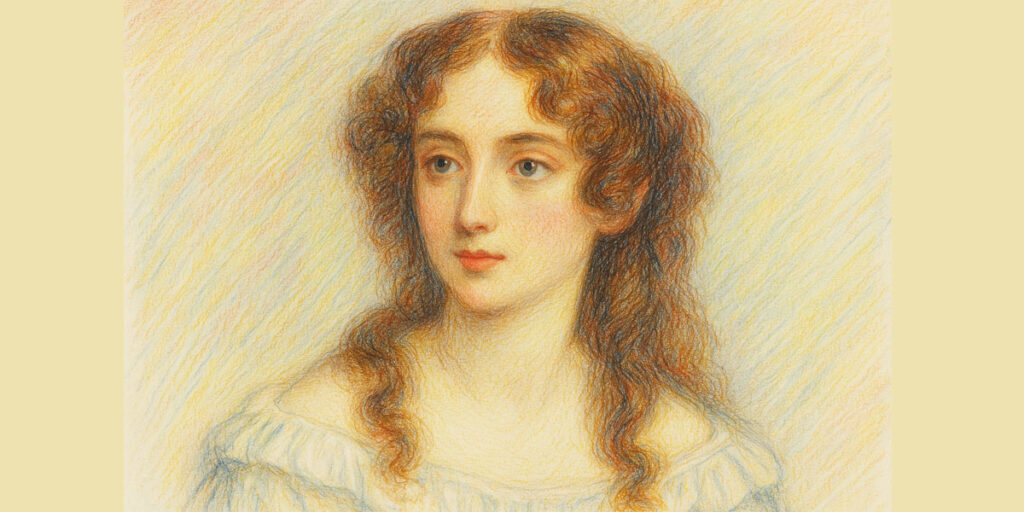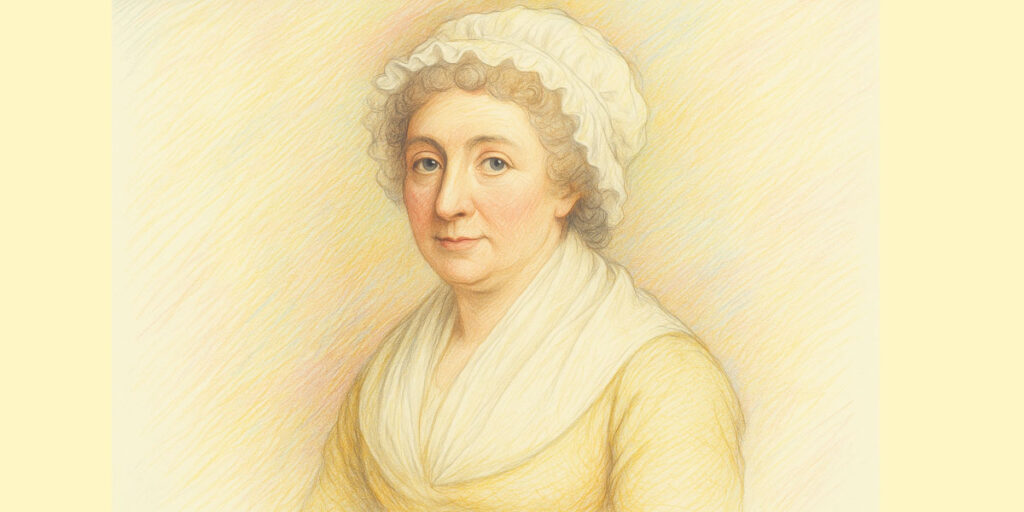The Enchanted Pen of Letitia Elizabeth Landon
In the cool morning light of August 14, 1802, a cry rang out from a genteel townhouse at Hans Place, Chelsea, in the beating heart of London. A daughter had been born to the Landons—John, a former naval officer turned investor, and Catherine, a woman of delicate poise and careful propriety. They named her Letitia Elizabeth, not knowing that her initials—L.E.L.—would one day become a whispered symbol of mystery, beauty, and poetic tragedy.
From the start, Letitia was different. She listened more than she spoke, devoured books faster than the maid could dust the shelves, and spent hours in sun-drenched corners, dreaming up stories. When the family visited her grandfather’s country farm near Tamworth, Letitia often wandered into the fields alone, composing verses in her head, humming tunes she would later put to paper. She was barely ten when she began to imitate the grand Romantic poets—Byron, Scott, and even Ossian. Her quill, though tiny in her young hands, was already busy sketching out the architecture of grief, love, and fate.
Her parents, wise to her rare intelligence, sent her to Mrs. Rowden’s School—an academy known for raising bright girls into cultured women. Letitia thrived. She studied French, mythology, and the classics, often surpassing even the boys in her grasp of literature. She learned to paint with words and to feel the rhythm of language not as mere sound, but as soul.
But no schooling could protect a family from economic storms. The post-war financial collapse in the late 1810s ruined John Landon’s investments, and the family had to move back to London under humbler means. It was in this turning tide that Letitia found the purpose of her gift: not only as art, but as salvation.
A Girl, A Pen, and A Secret Identity
Letitia began slipping poems to William Jerdan, the formidable editor of The Literary Gazette. He recognized the spark instantly. In 1820, under the delicate camouflage of her initials—L.E.L.—her first poem was published.
The initials weren’t just a pen name—they became a phenomenon. Readers swooned at the tenderness and melancholy of this mysterious poetess. Who was L.E.L.? Was she young? Was she beautiful? Was she even real?
Letitia remained silent and let the verses speak.
Her early breakthrough came with “The Fate of Adelaide” (1821), a romantic narrative poem steeped in noble sorrow and haunting imagery. But it was her second collection, “The Improvisatrice” (1824), that caused a sensation. Here was a woman’s voice—elegant, sorrowful, and passionate—crafted in refined rhyme and gilded sentiment. It was as if she painted her emotions in watercolors, each stanza a stroke on the canvas of longing.
Young women copied her lines into albums; painters asked her to write verses for their illustrations. Jerdan, meanwhile, became her editor, mentor, and—some whispered—more than a friend.
Queen of the Annuals
By the mid-1820s, Letitia had become a literary star in a new world of publication: the gift book. These were lavish, silk-bound annuals filled with engravings and sentimental verse—perfect for display on drawing-room tables. L.E.L. became the undisputed queen of this elegant genre. She wrote hundreds of poems, often paired with illustrations, transforming mere images into lyrical worlds.
She could write on command: give her a painting of a moonlit shipwreck, and she’d give you a heartbroken widow’s lament; show her a rose in a crystal vase, and she’d compose a tragedy of love lost at sea. Her words glittered with beauty but shimmered with something deeper—restlessness, constraint, and a cry for meaning beyond surface charm.
She became rich by literary standards. But with fame came suspicion. Whispers circled that Jerdan, her editor and employer, had fathered a secret child with her. A baby, born in shame, raised in secrecy. Letitia never confirmed nor denied. Instead, she bled her truth onto paper. Her novel “Romance and Reality” (1831) told of a talented woman destroyed by gossip and double standards. Critics read between the lines—and gasped.
Hearts Entwined, Then Torn
Letitia’s heart was not untouched by love. In the early 1830s, she became briefly engaged to the dashing novelist Edward Bulwer, later known as Bulwer-Lytton. But Bulwer’s mother, unimpressed by the scandal-draped poetess, forbade the marriage. Heartbroken, Letitia released him—and wrote again. Her novel “Francesca Carrara” became a monument of grief and lost possibilities, set among Italian ruins as poetic as her own soul.
Her fame grew beyond Britain. Edgar Allan Poe studied her closely, modeling his own poetic rhythm and tragic heroines after hers. Emily Dickinson would later treasure her verses. But Letitia, though adored, was exhausted. Her poetry had become a machine to feed the public hunger. The joy she once found in writing now slipped through her fingers like quicksilver.
And then, in the summer of 1836, a stranger entered her life: George Maclean, the tall, stoic governor of Cape Coast Castle in West Africa. Where others whispered verses, he spoke of treaties, of Africa, of empire. He was blunt, practical, and oddly fascinating. They married in secret in June 1837, and within weeks, Letitia—who had spent her life amid candlelight and crowded salons—boarded a ship bound for the Gold Coast.
She told her friends she was seeking peace. “I long,” she wrote, “for new skies, new duties, and a home all my own.”
The Castle by the Sea
Cape Coast Castle loomed white and sun-bleached against the crashing Atlantic. It had once been a fortress of the slave trade; now, it was the seat of British colonial rule in the region. Letitia, the only Englishwoman within miles, stood beneath its battlements in a silk bonnet and veil, her skin already weary from the sun.
She tried to make a life there. She painted. She tended a rose garden in tin tubs. She kept parrots and wrote stories. She helped run a small school for African boys and played the piano when the heat allowed.
But beneath it all, something ached.
In poems she sent home, a new voice emerged—less ornate, more honest. The old L.E.L. shimmered in metaphor; the new Letitia whispered from the soul. In one poem, written just weeks before her death, she wrote:
“I weary of the beating of my heart,
Of all life’s empty shows and bitter parting.”
Was it loneliness? Illness? Or something deeper still?
Death in a Locked Room
On the afternoon of October 15, 1838, just fifteen months into her African life, Letitia was found collapsed on the floor of her dressing room, clutching a bottle of prussic acid—hydrocyanic poison.
She died within minutes.
The castle doctor, panicked and puzzled, could not say with certainty whether it was an accident or suicide. Maclean claimed she had used the acid for cleaning a ring clasp. Others believed she took it to ease her frequent heart palpitations. But rumors, once more, swirled like smoke through the corridors of empire.
Had she quarreled with Maclean?
Had she uncovered something unspoken about his past?
Had she simply broken under the weight of a life built on expectations and exile?
The inquest, hasty and local, declared her death an “accidental overdose.” She was buried quietly in the castle’s courtyard, where waves crashed just beyond the fort walls.
Legacy in Ink
Back in England, the news arrived slowly—and then struck like thunder.
The London literary world reeled. Letitia Elizabeth Landon, L.E.L., the golden poetess of the annuals, was dead in Africa. Her fans cried foul. Her critics mumbled their regrets. Her defenders fought to protect her name, while biographers and gossipmongers dug deep into her life, searching for sins and secrets.
In the decades that followed, her fame dimmed. She was dismissed as sentimental, overwritten, and tragic. Victorian critics, unnerved by her independence and sexuality, pushed her out of the canon. By the early 20th century, her name had all but vanished from bookshelves.
And yet…
Her fingerprints are everywhere.
Poe’s “Annabel Lee.” Tennyson’s “Mariana.” Rossetti’s haunted verses. Dickinson’s epigrammatic poems. They all carry traces of L.E.L.—the rhythm, the imagery, the ache. Today, scholars and poets alike return to her work with fresh eyes, reading not just the glitter but the grief, not just the sentiment but the subversion.
Modern critics see in her poetry the early stirrings of feminism, the questioning of artifice, and the cost of fame in a world that demanded women be muses but not makers.
Final Words Beneath the Castle
There, in Cape Coast, beneath an unmarked slab in a courtyard awash with salt spray and sun, the poet rests. Her initials once adorned every elegant parlor in Britain. Her verses whispered from the lips of girls, her sorrow laced the dreams of lovers, and her stories shaped the imagination of a century.
Letitia Elizabeth Landon. L.E.L.
A woman who poured herself into words so beautiful, they nearly hid the pain inside.
But not completely.
And that’s why we still read her.
We read to listen—not just to the song of the poet—but to the heartbeat beneath the rhyme.
Letitia Elizabeth Landon’s literary career was both prolific and intensely expressive, spanning poetry, novels, and prose contributions to popular periodicals. Her first major published work was The Fate of Adelaide (1821), a melancholic narrative poem that introduced her flair for romantic tragedy and ornate language. This early success was soon eclipsed by The Improvisatrice (1824), which became her best-known and most beloved work. Framed around the fictional life of a passionate female artist, the collection fused verse, commentary, and emotional introspection—hallmarks of L.E.L.’s distinctive style.
Following its triumph, she published The Troubadour in 1825, a romantic medieval tale in verse that played to the popular fascination with chivalric love. A year later, she brought forth The Golden Violet (1827), again centered around poetic storytelling with an exotic flair. That same year, The Venetian Bracelet appeared, another richly imagined verse romance steeped in historical atmosphere and personal longing.
She continued this pattern with The Vow of the Peacock in 1835, a collection reflecting her increasingly mature tone, blending legend with commentary on gender and the constraints of beauty and virtue. In addition to poetry, she expanded into prose, publishing several novels that mirrored her personal experiences and societal critiques. Romance and Reality (1831) is perhaps her most autobiographical novel, a semi-satirical take on literary London and the emotional toll of being a female writer in the public eye. This was followed by Francesca Carrara (1834), a historical novel of political intrigue and doomed love, and Ethel Churchill (1837), her final and most introspective novel, written during her voyage to Africa and filled with reflections on fame, independence, and personal sacrifice.
Landon was also the principal poet for Fisher’s Drawing Room Scrap Book from 1832 to 1838, producing hundreds of short lyrical poems to accompany engravings. These poems, though often dismissed as “light verse,” showcased her versatility and command of narrative compression.
Each of these works contributes to the mosaic of L.E.L.’s legacy—an artist whose pen danced between beauty and sorrow, whose verses captured both the constraints and aspirations of her era.
🌸 The Velvet Mask: A Review of the Poetry of L.E.L.
Letitia Elizabeth Landon, writing under the enigmatic initials L.E.L., was once a literary sensation—her verses gleamed from the pages of every drawing-room annual in Regency and early Victorian England. Today, reading her poetry is like stepping into a forgotten garden, overgrown with roses and shadows, where sentiment wears a silken mask and sorrow whispers behind every petal.
What strikes a modern reader first is the ornate beauty of her language. L.E.L.’s poems are drenched in color, perfume, and light. She doesn’t simply describe a sunset; she threads it with gold and dying roses. She doesn’t merely evoke sadness; she wraps it in pearls and ties it with a silken ribbon. Her verses are often likened to the paintings of the Pre-Raphaelites—lush, intricate, and poised between dream and drama.
Yet beneath this decorative surface lies something far more daring: a poet dissecting the female experience in a world that demanded silence or sweetness. Again and again, her poems explore themes of love betrayed, ambition thwarted, and identity blurred by performance. In The Improvisatrice, the title character sings her heart into verse while being consumed by the very act of performance. L.E.L. seems to ask: What happens when a woman is loved for her art, but not allowed a real life beyond it?
Many of her poems begin with paintings or sculptures—ekphrastic meditations on beauty—but then twist into explorations of captivity, isolation, or loss. This pattern reflects L.E.L.’s own double existence: the dazzling public poet, and the private woman silenced by scandal and societal pressure.
Her shorter pieces, especially those written for Fisher’s Drawing Room Scrap Book, often pack emotional punch in only a few quatrains. There is music in her rhyme and a disciplined control in her rhythm, but within that control, deep emotional turbulence. Take her poem “Felicia Hemans,” in which she eulogizes her fellow poetess and, through the lament, reflects on her own fate. It is not merely homage—it’s a subtle acknowledgment that art and isolation often walk hand in hand for women who dare to speak too much.
Critics of her time sometimes dismissed her as overly sentimental, and some modern readers may find her diction florid. But this is a misreading of both her intent and her artistry. Her sentiment is not weakness—it is weaponized. Her emotion is not indulgent—it is revealing. In an age where women’s voices were often ornamental, L.E.L. used the expected ornamentation to sneak in revolution.
And then, there’s the melancholy—persistent, glittering, elegant, devastating. Even her love poems are haunted by absence. Even her triumphs smell faintly of ruin. As one reads more deeply into her work, it becomes clear that Landon wasn’t merely romantic—she was philosophical, in the way that only a woman balancing creativity and constraint could be.








